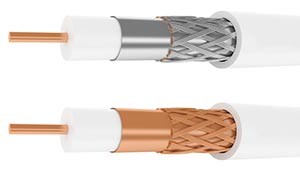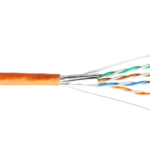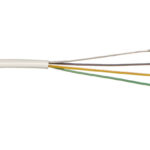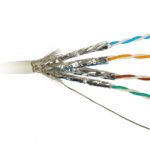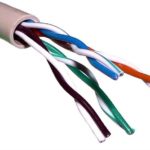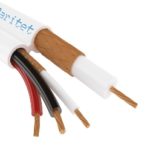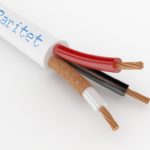When installing the intercom, special attention is paid to the quality of the cable - whether it meets all standards and requirements. This is due to the fact that not all types of wires are suitable for establishing communication between a visitor and a subscriber.
Intercom wire requirements
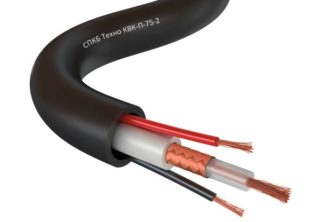
Each type of construction work has its own specific and general operating requirements. For intercom wires, they are as follows:
- To power the external unit and electronic lock, the voltage should not exceed 24V.
- If frequent voltage fluctuations are observed, it is recommended to temporarily de-energize the device, otherwise the probability of a short circuit and fire increases.
- The intercom and all auxiliary elements are placed away from sources of moisture and an environment with high humidity.
- Requirements for the insulating layer apply only to those wires that are outside. Their surface should be wrapped in polyethylene insulation.
- If there is damage to the cable as a result of mechanical, chemical or thermal effects, the damaged section of the chain or the entire cable is replaced.
RK-75 - Coaxial cable for connecting a video intercom with a copper center conductor - The electromagnetic field emanating from some types of wires can distort the operation of the intercom, therefore it is more advisable to give preference to modifications equipped with separate shielding.
- If the resistance value is 20 ohms, the device is used for long distance communication.
For the smooth operation of the electromagnetic lock, electricians recommend connecting a separate cable to it.
The length of the wire directly depends on the distance of the call panel. If the distance is not more than 15 meters, any kind of cables are used; if the interval is much larger, experts recommend considering the following models:
- UTP;
- STP;
- FTP;
- KSPV-4 * 0.5;
- ShVEV;
- ShVEP.
The peculiarity of the models lies in the combined structure. They are designed to work both indoors and outdoors along the entire perimeter.
Model Description
There is a wide variety of cables and each one is used for a specific purpose.
| Cable brand | Description |
| ShVEP and ShVEV | Specially designed for connecting video door phones. This is confirmed by the presence of one core with a screening braid. They are used to connect the system over long distances without distorting the image and sound quality. |
| KSPV | The model is universal. Used to connect both audio and video intercom, but over short distances. Also, KSPV is common for connecting the system in apartment buildings. Experts attribute the inconvenience of installation due to high rigidity to the main disadvantages of the model. |
| Twisted pair UTP 5e | It is used to connect systems over short distances (no more than 10-15 meters). For connection, UTP 2 and UTP 4 are additionally used. The main disadvantages include a low degree of noise immunity. |
| KVK-2P | It is preferable to use it for summer cottages and country houses when the call panel is located on the street. To ensure that the camera is constantly provided with voltage, a separate line is laid. To save money, it is better to give preference to combined models. There are 2 types of conductors inside the winding. One of them is coaxial, its resistance reaches 55 ohms.The shielded core is located in the center, two lines for power supply run parallel to it. |
The assortment of cables in stores is extremely large. To choose the most suitable one, you need to familiarize yourself with their characteristics and compare with the system requirements.
Video intercom cable
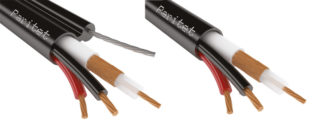
Intercom systems equipped with video are quite demanding, therefore, they are vigilant when choosing auxiliary components and performing installation work.
For high-quality and uninterrupted operation, four-core cables are connected to the system. Also, experts advise buying models with a separate shielded core. This will improve the image quality. The shielded core protects the signal from interference.
At the stage of installation work, first of all, wires are laid between the monitors and the outdoor panels. Each of these devices must be included in the overall system.
Power supply in the 12 V circuit, this testifies to the complete safety of the use of such wiring.
In order to avoid emergency and abnormal situations, the wires for the intercom are laid separately from the power electrical lines.
How to choose a wire for an intercom
Before proceeding with the selection of the wire, they are determined with the type of intercom to be installed. If the system is equipped with an audio system, a two-wire intercom wire is used.
If the system is with a video intercom, it is worth taking special care when choosing a cable, since these devices are very demanding and capricious. They require a minimum of 12V. In this case, four-wire wires are used to provide communication with the panel, built-in monitor and to ground the structure.
When choosing a wire, the distance over which the signal will be applied is of great importance. The larger it is, the longer the wire and its cross-section should be, since the signal quality will depend on this.
Laying and Installation Recommendations
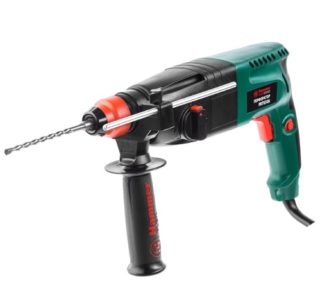
Before starting work, you need to prepare working equipment and consumables.
- construction knife;
- self-tapping screws (their number depends on the number of connected devices);
- latex gloves;
- putty;
- insulating tape;
- cable (length, cross-sectional size and model are selected individually);
- puncher;
- nippers, screwdriver and pliers.
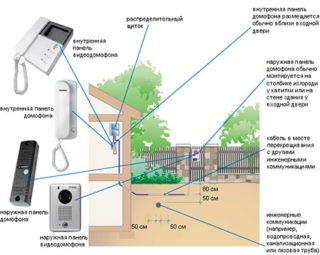
When all consumable and working equipment is prepared, they begin to familiarize themselves with the recommendations and the algorithm for laying wires for the intercom:
- To implement two-way communication, it is required to calculate the footage by measuring the distance from the intercom to the unit.
- The cable is selected depending on the length.
- If the intercom is installed at the entrance of a multi-storey building, a common riser is drawn inside, along which wires will stretch.
The issue of careful masking of wires deserves special attention. This is required to create an aesthetic appearance and restrict access to them. If the wires are not hidden, the robbers will easily cut the cable and the owners of the living space will not react to the potential danger in a timely manner.

